|
4
Adrian visits the Sufi, finds a new message, avoids three booby traps,
catches a thief, gets an idea and visits the Sufi again
Library
 Talk to the Sufi about the message. The Sufi thinks the man is obsessed with the number three and that he likes to talk in riddles. Talk to the Sufi about the message. The Sufi thinks the man is obsessed with the number three and that he likes to talk in riddles.
Adrian says; "He referred to the introduction to Ecclesiastes: "Vanitas, Vanitatis."
The Sufi thinks the man has a lot of vanity himself, they must find out what he wanted to show by that.
About what The Holy Lamb might mean the Sufi thinks that it is one of the elements of the triangulation that reveals the word, and that is simple explaining the picture because John the baptist was the first to call Christ the Lamb of God. He also tells that Jacob is the elected of the Patriarchs according to the belief of the Hebrew people.
Jacob was the son of Isaac and the grandson of Abraham. He had an older twin brother Esau whose birthright he usurped with the help of his own mother Rebecca. To escape Jacob hid in his uncle Laban's house and married his Laban's two daughters, Lea and Rachel. He had twelve sons born by them and his servants, and these were the ancestors of the twelve tribes that formed the Jewish people.
Mohammed is called the seal of the Prophets because they think that he closes the cycle of the Revelation.
God shall not send another Prophet after him and Humanity shall have to wait until the end of time for the veil covering the Mysteries of the divine plan to be lifted.
When Adrian asks about the exact meaning of the revealed Word the Sufi says that there are only four ways of thinking about the world and one is common to the three religions of the book and it states that the universe is the result of a Unique Creative Will that we call God. God is known to us through his Prophets, to whom he reveals all his Laws and plan for man, his beloved creature.
Some wise men in India thinks that the visible universe can be perceived as a pure and simple illusion and human energy must be entirely devoted to tearing away the veil of appearance that hides the truth.
The materialists think that man can have enough pride to believe that reality is only the physical universe around us.
Many philosophers from Ancient Greece were materialists such as Xenophon or Parmenid.
About the forth way to see the world, the Sufi thinks it is the most dangerous. It's the way of the idolaters, the pagans.
It says that there is not a single God, creator of the universe, but that all visible space is inhabited with forces with which men can commune.
It was the religion of the Arabs until Mohammed came to bring us the Word of Allah. We call that time Jahiliyyah, the Time of Ignorance, but that period is over now.
Leave the Sufi when you have talked about all the subjects.
Prison Cell
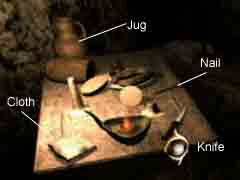
When you choose Jail at the map you are taken directly to Hayyats cell where you find Ozdemir waiting for you.
Tou tell him that you are looking for a word found in a triangle made up of three places marked by Jacob, Jesus and Mohammed.
Ozdemir who has been studying the maps thinks the solution lies there.
Adrian agrees. A triangle linking the maps with the corners marked by the Cathedral of the Rock twice to commemorate Jacob and Mohammed and by the Saint Sepulchre once in memory of Jesus.
(The Cathedral of the Rocks is built on the site where Solomon's temple once stood. Therefore this site is holy both for Jews and Moslems.)
Go to the table and pick up the knife, the rag, the jug and the nail.
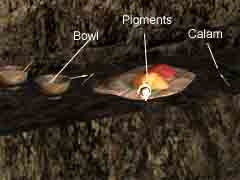
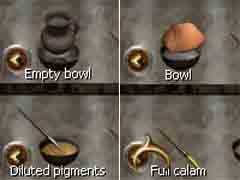 Go to the bench at the wall opposite the paintings and pick up the pigment, the empty bowl and the calam (quill). Go to the bench at the wall opposite the paintings and pick up the pigment, the empty bowl and the calam (quill).
In the inventory first combine the jug of water with the empty bowl to get a bowl. Combine the pigments with the bowl to get diluted pigments. Combine the calam with the diluted pigments to get a full calam.
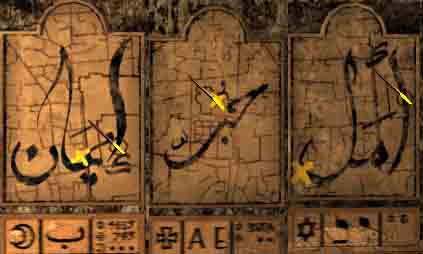 Go to the triptych. At the left painting point at the small circle to the right of the cross. When the calam highlights, click. Go to the triptych. At the left painting point at the small circle to the right of the cross. When the calam highlights, click.
At the middle painting point at the cross. When the calam highlights, click.
At the right painting point at the small circle near the the right edge of the painting, When the calam highlights, click.
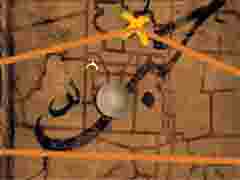 Adrian takes the calam and marks the three points and draws a triangle between them. Adrian takes the calam and marks the three points and draws a triangle between them.
In the middle of the triangle you see a wax-plug.
You can't just take it you must find another way to remove it.
Wax melts if it is heated.
Zoom out and go to the table. There is a burning oil-lamp.
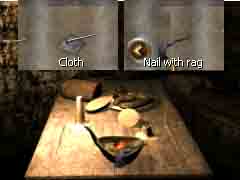 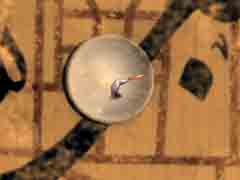 In the inventory combine the nail with the rag. In the inventory combine the nail with the rag.
Use the combination on the lamp and you'll get a heated nail.
Use the heated nail on the wax-plug to melt it.
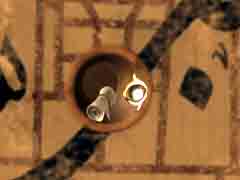 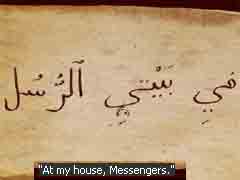 Behind, you find a scroll, take it. Behind, you find a scroll, take it.
It is a new message written with Arabic letters.
"At my house, messengers," translates Ozdemir. "
"The corners are the places of the three Revelations and the uncovered word is not that of God, it is his," says Adrian. Is it not strange, this type of supreme vanity. Here is a man who takes his word to be the word of God and yet he accuses himself of vanity."
"Unless we've misinterpreted his reference to Ecclisiastes," answers Ozdemir. "He doesn't take himself for God but for Quohelet the king of Jerusalem and author of this book. and whom tradition identifies as Solomon himself. And so he is not referring to the introduction but to the conclusion.
Vanity of Vanities, Quohelet said, all is vanity. The fact that he taught science to his people, adds to this character's wisdom."
"We have yet to discover what the science is that Hayyat wants to teach us," says Adrian.
"Let us drop our vanities," answers Ozdemir, "and go to his house to find these messengers. Ibrahim must know where he lived before he was imprisoned. I shall ask him to take us there."
Holy Sepulcre - Hayyat's rooms
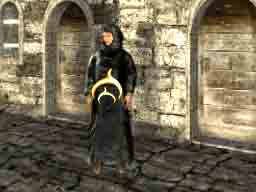
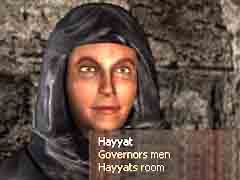 Next moment you find yourself at the Saint Sepulcre. Next moment you find yourself at the Saint Sepulcre.
Take a step forward and turn right.
Talk to the woman, she is the widow Pichon.
She is frightened and says that she has not touched his room not before nor after but Adrian tells her not to fear, he only wants to ask some questions.
Ask her about everything.
She has not seen or heard about any messenger. No one has visited him.
Adrian said that the messengers might have been angels, but she says that Hayyat never spoke to her about angels either.
The governors men have been there though, telling her not to touch anything
She thinks Hayyat was a very nice man and very knowledgeable. She has let the room to him for about four or five months.
He used to tell her religious stories but she said she mixed them all up because he talked too much.
One day he didn't return and she learned that he had been arrested.
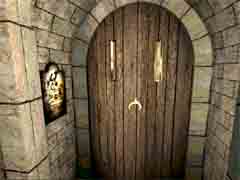
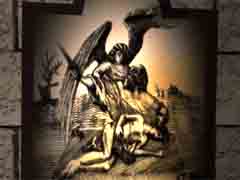 After that you find yourself and Ozdemir in Hayyat's room. Look around. The entrance door is behind you and to the right of it you can see a big chest but it is locked. Turn around and go into the other room. Turn left and go forward. There is a picture at the right. Zoom in on it. It shows the Angel Gabriel preventing Abraham from sacrificing his son Isaac, ancestor of the Hebrews without whom Christianity and Islam would never have appeared After that you find yourself and Ozdemir in Hayyat's room. Look around. The entrance door is behind you and to the right of it you can see a big chest but it is locked. Turn around and go into the other room. Turn left and go forward. There is a picture at the right. Zoom in on it. It shows the Angel Gabriel preventing Abraham from sacrificing his son Isaac, ancestor of the Hebrews without whom Christianity and Islam would never have appeared
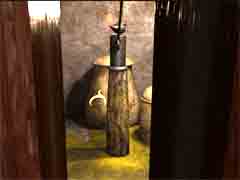
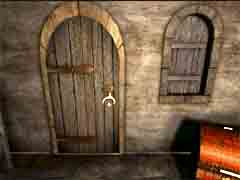 Look at the door to the right of the painting. You can peep into one of the small windows. You can see a burning oil-lamp and there is also sulphur at the floor. This must be a booby-trap that you have to avoid. The only way to prevent a fire, is to blow out the lamp. If you could find a window on the outside you might make the wind help you, just as you made the wind blow out the word earlier. Exit the house through the entrance door. Look at the door to the right of the painting. You can peep into one of the small windows. You can see a burning oil-lamp and there is also sulphur at the floor. This must be a booby-trap that you have to avoid. The only way to prevent a fire, is to blow out the lamp. If you could find a window on the outside you might make the wind help you, just as you made the wind blow out the word earlier. Exit the house through the entrance door.
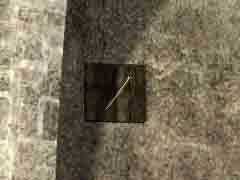
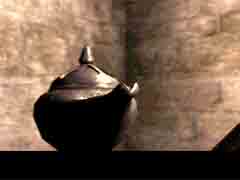 Turn right and go through the narrow arch. Turn right again and look up at the wall. There are two closed shutters but they are to high up. You can't reach them. Turn right and go through the narrow arch. Turn right again and look up at the wall. There are two closed shutters but they are to high up. You can't reach them.
Take the branch from inventory and use it on the shutters. Adrian uses the branch to open the shutters and you can see that the lamp is blown out by the draught. Now it must be safe to enter the room.
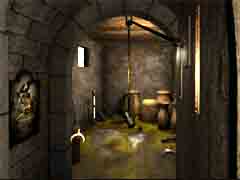
 Return to the house and go to the back door. Open it and enter. The lamp has fallen from the pillar. Look down and take it. Return to the house and go to the back door. Open it and enter. The lamp has fallen from the pillar. Look down and take it.
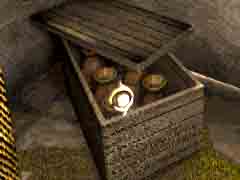
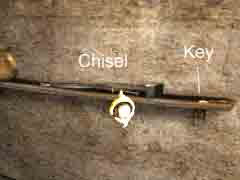 Turn left and look into the corner. Take the bellows from the chest. Look at the shelf on the wall. Take the chisel and the David's star shaped key Turn left and look into the corner. Take the bellows from the chest. Look at the shelf on the wall. Take the chisel and the David's star shaped key
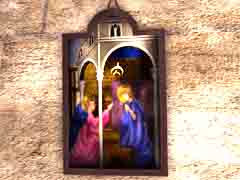
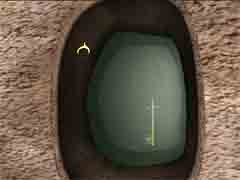 Exit the room. Turn left, go forward and look at the picture on the wall showing the tidings brought to Mary. Click at the picture once more. Adrian removes the picture. The recess is covered with a thin membrane and filled with liquid and at the bottom there is a key Exit the room. Turn left, go forward and look at the picture on the wall showing the tidings brought to Mary. Click at the picture once more. Adrian removes the picture. The recess is covered with a thin membrane and filled with liquid and at the bottom there is a key
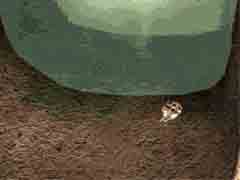
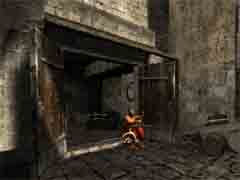 When Adrian looks at it, a small bug is sipping up a drop of the liquid and dies. When Adrian looks at it, a small bug is sipping up a drop of the liquid and dies.
Adrian realizes this must be another booby-trap.
You have to suck up the liquid before you can take the key. The bellows might do.
Use the bellows on the trap. No luck. Adrian says he needs a finer nozzle.
Leave the house. Go right through the arch and turn left.
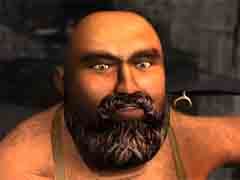
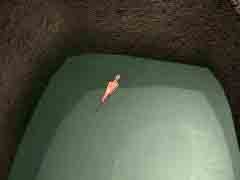 Talk to the blacksmith, Ibn an-Nur. Adrian asks if could make him a very thin nozzle. No problems. And he doesn't even charge Adrian. Talk to the blacksmith, Ibn an-Nur. Adrian asks if could make him a very thin nozzle. No problems. And he doesn't even charge Adrian.
Adrian thanks him and says that he is a very chivalrous man.
Combine the nozzle with the membrane and you'll get Modified bellows.
Return to the trap and use the modified bellows on the recess. Adrian sucks up the poison and you get green Poisonous bellows.
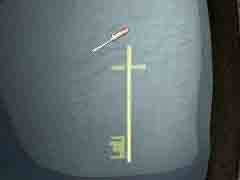
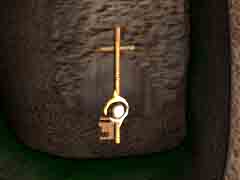 Use the chisel on the membrane to break it, then take the Cross key Use the chisel on the membrane to break it, then take the Cross key
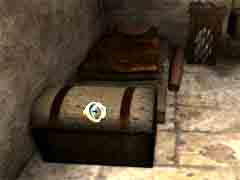 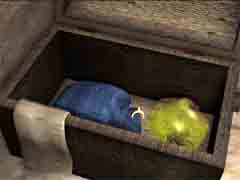 Turn right and look at the chest at the foot of the bed. Turn right and look at the chest at the foot of the bed.
Click at it to open it. Click again to remove the cover,
Take the container with the scorpions.
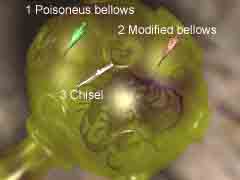
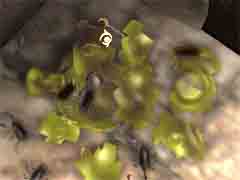 There probably is something hidden inside but you have to kill the scorpions to get it. There probably is something hidden inside but you have to kill the scorpions to get it.
First use the poisonous bellows on the container to fill it with poison and kill the scorpions.
When they are dead use the Modified bellows to suck out the poison.
At last use the chisel to break the container. Take the Crescent key.

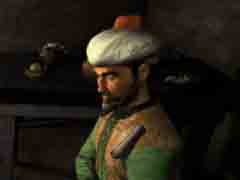 Go to the outer room and look at the chest to the right of the door. Go to the outer room and look at the chest to the right of the door.
Put the three keys in the keyholes. To the left David's Star key, in the middle the Cross key and to the right the Crescent key. Click at one of the keys to turn them, then click again to open the chest.
Pick up the three things from the chest and show each of them to Ibrahim.
He tells you that the prayer mat is called sadjada, and used by Moslems.
The Talith is a prayer shawl of the Jewish liturgy.
And the cross is the instrument of the Passion of Christ.
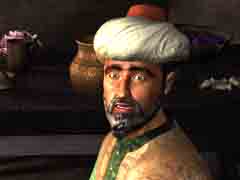 "Two things are confusing me Ozdemir," Adrian says. "The first is how a man as poor as Hayyat can have objects of such value in his possession. This chest contains some real treasures." "Two things are confusing me Ozdemir," Adrian says. "The first is how a man as poor as Hayyat can have objects of such value in his possession. This chest contains some real treasures."
"Hayyat seems more interested in spiritual riches than material objects," Ozdemir answers. "But what is your other source of confusion?"
"It is more serious," Adrian says "All the traps that gave out the keys were deadly. Up to now Hayyat has always been devious to us but never dangerous."
"You are forgetting that he kidnapped Hykmah," Ozdemir says "Some would say that is quite dangerous behavior. Nevertheless it is true that we should be doubly careful from now on. Do you understand what I am talking about?"
"Yes," Adrian answers. "The trap in the box room must have been set only recently. Hayyat could not have filled the oil-lamp from his cell. So either he has an accomplice or..."
"Or," Ozdemir fills in, "someone is manipulating him and using this treasure hunt for their own means."
"To follow the tracks that we have just discovered, "Adrian says, "I think I shall have to make use of some of my contacts."
When you get the map choose the Ramban Synagouge
Ramaban Synagouge
 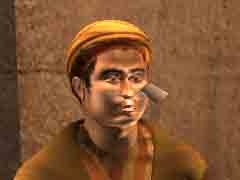 Go forward twice. Then turn left and go to the man, Isaac, standing beside the Synagogue door. Go forward twice. Then turn left and go to the man, Isaac, standing beside the Synagogue door.
Use the Talith on him. Adrian asks what it is and Isaac answers that it is as shawl they use for morning and evening prayers. He has never seen anything so splendid before and says that the phrase written on it truly beautiful.
Talk to him as long as you get subjects.
Isaac says that his master Kalonymus went to pray at the Wailing Wall and you can find him there if you wish.
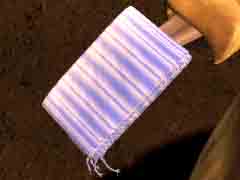 Adrian says that he does not see any writings on this shawl but Isaac tells him to look at the tsitsits, the fringes around the shawl. There are couples of knots separating the spaces, with threads running through each one. The number of turns the threads make are all different. That is because they indicate the order of the letters in the alphabet. The phrase is not written with letters but with numbers. But for those who follow the tradition that God taught Adam in the garden of Eden it is the same. They read numbers as well as they can add words. Adrian says that he does not see any writings on this shawl but Isaac tells him to look at the tsitsits, the fringes around the shawl. There are couples of knots separating the spaces, with threads running through each one. The number of turns the threads make are all different. That is because they indicate the order of the letters in the alphabet. The phrase is not written with letters but with numbers. But for those who follow the tradition that God taught Adam in the garden of Eden it is the same. They read numbers as well as they can add words.
Then Isaac tells Adrian that "God is One" is written on the Talith, and the number associated is 39.
Associating numbers with letters is called Gematry and is one of the aspects of the Kabala which is the secrets sent to Adam from God while Adam slept for him to name Creation. (Kabala is often spelled Cabala or Cabbala.)
The Cabalists think that the scriptures, in the primary meaning only show one of the numerous realities of the world. By studying and meditating on the Holy Books man must open all the other doors, and bring out all other meanings. That is what the Kabala is for.
Some people use it for superstitious means. But there is a story in the Zohar that shows that the Kabala's greatest power is not magical.
Rabbi Simeon and his son met an angel as big as a mountain who told them that he was going to destroy the world because that there were not 30 Righteous Men in the generation of the time.
Simeon replied, "The two of us My Son and I are enough to protect the world as it is written - Any word (dabar in Hebrew) shall be established upon the deposition of two witnesses.
Now dabar also means world when written - By the word (dabar) of God the heavens were made.
At this moment a heavenly voice sounded out: "Happy may you be Rabbi Simeon, you who have the power to repeal the decrees of the Holy One, blessed may he be."
The story shows how knowledge and cabalist manipulation of the language avoided destruction of all Humanity
Zohar is the book of Splendors, the most important book of the Kabala. Some say it is the work of a single author, who died two and a half centuries ago - the Castilian Moses of Leon.
Others believe that the Zohar is not an original work but a collection of sometimes very old cabalist works. Wherever truth can be found, the Zohar is considered to be a little like the counterbalance of the Talmud
It is said that in Paradise Adam carried the entire Torah on his face. But none of the letters that made up the text were separated. This gigantic word was the great name of the one God.
But once the first man had sinned, the letters were mixed up and separated one after another.
By manipulating the language the Cabalists try to rebuild the order of the primordial Torah. When they find a fragment of it or discover a link between two terms that had lost their identity, they can even cancel divine decrees. That is what the story of Rabbi Simeon and his son shows us.
The largest part of Jewish law is contained in the Torah. But it is accompanied of the rabbinical laws of the Halakha, the Mischnah, which is the record of verbal laws, handed down in ancient times, and the Talmud, which is a commentary to these.
The Zohar shows slightly less rigid and legalist hopes and thoughts than those expressed by the Talmud. Talmudists were Pharisees who approached the mysticism and interiority of religious feelings with some mistrust.
Perhaps a picture can clarify everything. Imagine that Judaism is a mountain. The Talmud is the slope facing the light where the villagers stand, and the Zohar is the side that remains in the shade and is only visited by those who are not contented with the Talmud, those Maimonides calls the lost. But what would the sunny side be without the other side to support it. It would collapse and there would be no mountain. And does anyone like flat countryside.
The pharisees were the ruling class of the Jewish people until Jerusalem was destroyed by the Romans, 70 years after the Christian Messiah. The Pharisees did not have a good position in the Gospels because they fought violently against Jesus, whom they took as an agitator.
Maimonides was temporary with St. Thomas of Aquino and like him, Maimonides tried to reconcile rationalism borne out of Aristotle's philosophy and the mysticism of Faith.
The Hebrews were taken to Babylon as the spoils of war by king Nebuchadnezzar of Babylon in the year 586 BC of the Christian era. The destruction of the first temple dates back to that time. Half a century later the Persian king Cyrus, freed them and allowed them to return to Jerusalem and build the temple and even the walls of Jerusalem.
When there are no more subjects left, leave Isaac and walk through the alley.
Wailing Wall
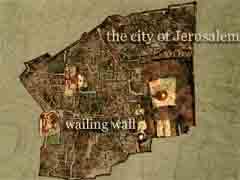
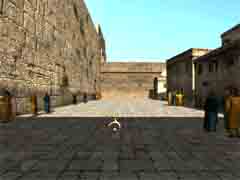 When you get the map choose the Wailing Wall to meet with Kalonymus. When you get the map choose the Wailing Wall to meet with Kalonymus.
Take a step forward and turn left.
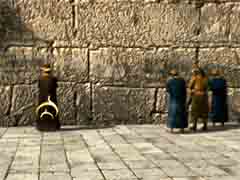
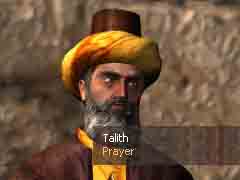 Kalonymus is the man who is praying alone at the centre of the Wailing Wall. Talk to him. Kalonymus is the man who is praying alone at the centre of the Wailing Wall. Talk to him.
Kalonymus comes to the Wailing Wall to pray as an act of fervor hope and remembrance, because these walls are the remembrance of a revolutionary time for the Jewish people, the time of their independence, unity and strength. He prays that one day the children of Zion will again be reunited in the promised land and will be able to rebuild the temple of Solomon so they can complete their destiny as leaders of all Nations.
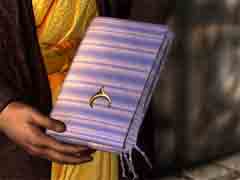 Adrian thinks it a little strange that a man as poor as Hayyat should have a shawl of such value in his position. Kalonymus answers that it is not unusual for poor men to be very pious and spend the little means they have on religious objects rather than satisfy more mundane needs. Adrian thinks it a little strange that a man as poor as Hayyat should have a shawl of such value in his position. Kalonymus answers that it is not unusual for poor men to be very pious and spend the little means they have on religious objects rather than satisfy more mundane needs.
But here is something unusual about the talit - a tiny embroidery of silver threads through two of the dark bands. The inscription is a name and a date from the Hebrew calendar. Burgos 5252, and that is strange because talits usually do not contain that sort a text.
There was a large Jewish community in Burgos once. Adrian asks what year in the Christian Calender 5252 corresponds to. Kalonymus knows that the Jewish calender starts with the creation of the world 3761 years before the Christian's Messiah. Then he tries to calculate but gives up.
You get four circles on the screen.
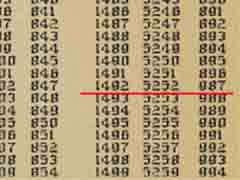 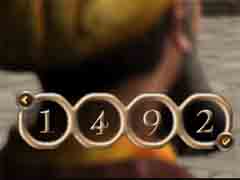 Get the conversion table from the inventory. Page to the last page and search for the Jewish year 5252 and you get the corresponding Christian year 1492 so enter the year 1492 by dragging the zeros. Get the conversion table from the inventory. Page to the last page and search for the Jewish year 5252 and you get the corresponding Christian year 1492 so enter the year 1492 by dragging the zeros.
(You can use simple arithmetic to get the year but if you just subtract 3761 from 5252 you get 1491 but that is not correct because you have included year 0 in your calculation and that year does not exist in any of the religious calendars so to get the right year you must add 1.)
1492 was the year when the Jews were expelled from Spain and whoever carried this talit in Burgos at that time must have had a difficult time because it was a time of forced convention, escape or death, they had no other choice. Hayyat is 67 years old, same as the Rabbi and as it is 1552 now, he was born in1485. He is a Jew but gave up the religion of his forefathers and created his own system which was a sort of syncretism between the three religions of the book.
The Moslems and The Christians named the place the Wailing Wall but for the Jews it is rather the Wall of Hope.
Zion is the fortress taken by King David. He made it his city and called it Jerusalem, the city of peace. But in the Scriptures Zion also means all Judea and even all the people of the House of Israel.
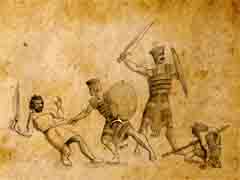
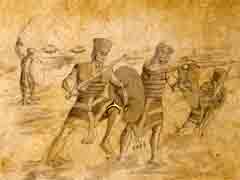 Adrian wants to hear more about David and Kalonymus is happy to tell him the story: Adrian wants to hear more about David and Kalonymus is happy to tell him the story:
At around the time when Homer told the story of the war of Troy, 1250 years before the birth of Jesus Christ, invaders arrived on the coast of the east. Among them,the Philistines, brandishing Iron swords and driving Chariots of war.
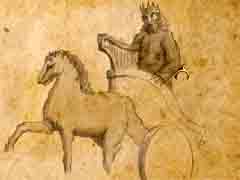
 The enemies clashed with the Israelites who, without a leader, and almost without arms to defend themselves, suffered heavy losses, until Samuel a priest of the one God, made Saul king of Israel. Then things began to turn. Moab, Edom and all the other enemy kingdoms of the Hebrews, were soon defeated. The enemies clashed with the Israelites who, without a leader, and almost without arms to defend themselves, suffered heavy losses, until Samuel a priest of the one God, made Saul king of Israel. Then things began to turn. Moab, Edom and all the other enemy kingdoms of the Hebrews, were soon defeated.
But because he spared an enemy, and thus disobeyed Jahweh, Saul was abandoned by Divine Benevolence.
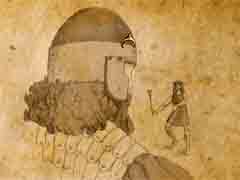
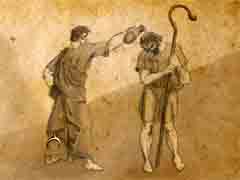 Upon Saul's death, David who had already been crowned with glory for having killed the warrior giant Goliath, succeeded Saul to the throne and asserted the supremacy of the Hebrews over the land of Canaan. Upon Saul's death, David who had already been crowned with glory for having killed the warrior giant Goliath, succeeded Saul to the throne and asserted the supremacy of the Hebrews over the land of Canaan.
David took Jerusalem and Solomon, his son, built the First Temple where the Ark of the Covenant was kept. But when Solomon died the land of the Hebrews was divided into two kingdoms, Judea to the south and Israel to the north. And the Hebrew people found division and pain.
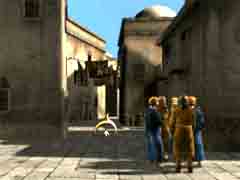 The architect of first sanctuary was Master Hiram of Tyr who knew great secrets. The Temple housed the Ark of the Covenant, a chest where the Tables of the Law were kept.. The First Temple was destroyed when the city was taken by the king Nebuchadnezzar of Babylon, that was when the Ark disappeared. The Second Temple was destroyed by the Romans when they took Jerusalem in 70 of the Christian era.
The architect of first sanctuary was Master Hiram of Tyr who knew great secrets. The Temple housed the Ark of the Covenant, a chest where the Tables of the Law were kept.. The First Temple was destroyed when the city was taken by the king Nebuchadnezzar of Babylon, that was when the Ark disappeared. The Second Temple was destroyed by the Romans when they took Jerusalem in 70 of the Christian era.
Adrian thanks Kalonymus and says that he will never forget what he has learned an Kalonymus answers that Memory is the sister of Truth, as surely as Forgetting and Lying are their evil opposites.
Take the alley behind the rabbi . When you get to the map choose Saint Sepulchre.
Saint Sepulchre
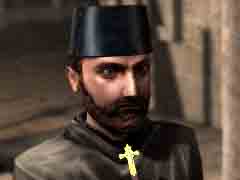
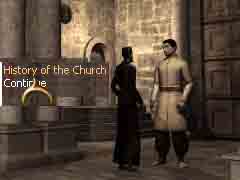 Cross the square and enter the Church- Palmede is waiting for you. Cross the square and enter the Church- Palmede is waiting for you.
Give him the Cross.
He says that Hayyat many time had asked him about the history of the church. He already knew a lot about the subject but he always wanted to know more and expressed some strange opinions about it too. He wanted to know what language the Gospels were written in. The Gospels were written in Greek but Hayyat believed that they had been written in Hebrew.
He also wanted to know when the Christian religion became the only religion of the West. He was troubled about the way Constantine imposed the Christian religion on the Roman Empire.
It is true that Constantine had been responsible for some terrible crimes that even the priests of his ancestor's religion could not absolve. According to Hayyat his conversion was not the result of a revelation, but rather made for personal gain. A Christian bishop was supposedly the only one who promised him forgiveness for his sins on the condition that he made the Empire a Christian land. The first state to convert entirely to Christianity, though, was Armenia at the beginning of the Forth Century.
Between 132 and 135 AD the Jews yet again battled with Rome. Bar Kochebas was the leader of the rebellion. He took refuge at his fortress in Bethar with his men but was defeated by the Emperor Hadrian. After that final revolt, Jerusalem was forbidden to all Jews and became a Pagan city named Aelia Capitolina,
When there are no subjects left, leave Palmede and go to the alley where you find the map.
This time choose Madrassa.
Madrassa Tankiziyya
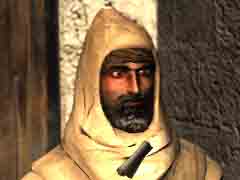
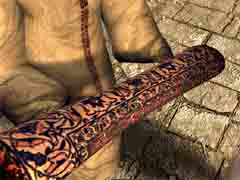 The imam is meditating before the school but he seems happy to be interrupted. The imam is meditating before the school but he seems happy to be interrupted.
Show him the prayer mat.
Adrian says he knows it is a Sadjada but wants to know its symbolic value for the Moslems. The Imam answers that the Sadjada is like a door but a door that opens onto a specific time not to a place. This time is the time of Intimacy with the Creator. He can't see anything special with the mat but tells Adrian to consult Master Jamal the head of the Tariqah for carpet masters but unfortunately he left for Hajj with the caravan before last and shall not be back for some weeks.
The Tariqah are more than a simple group of craftsmen, to be a member of the Tariqah is to follow the path of a true master of skill, as most of their patriarchs are also Sufis. That is why the Empire helps to develop there brotherhoods.
When Selim the father of Soliman fought the Mameluke dynasty of Cairo he rallied the Sufis to his cause,. The Sufis were much respected by the people because for a long time they had opposed the Egyptian Sultans and their severe and inefficient form of government that was non the less supported by Sunni dignitaries. That is how the Sufis became allies of the new political regime. It is an edifying reversal of the situation.
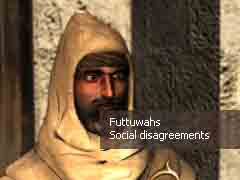 As the Sufis now has a similar role to the Sunni Ortodoxy in the time of the Mamelukes there is no opposition as such but sources of popular discontent are sometime voiced by the members of the Futuwwah which is a kind of brotherhood of young people with very strict codes of honour. Since the European found shipping routes to go and find spices and silk from India themselves the cities no longer have the same importance for trade. They are beginning to loose their wealth but the state does not understand this and continues to ask for more tax, and so young people in the Futuwwahs are agitated and they are very sensitive to questions of social justice. The Imam thinks that Hayyat can have been in contact with some of these people and Adrian thinks he might have met one of them himself.. As the Sufis now has a similar role to the Sunni Ortodoxy in the time of the Mamelukes there is no opposition as such but sources of popular discontent are sometime voiced by the members of the Futuwwah which is a kind of brotherhood of young people with very strict codes of honour. Since the European found shipping routes to go and find spices and silk from India themselves the cities no longer have the same importance for trade. They are beginning to loose their wealth but the state does not understand this and continues to ask for more tax, and so young people in the Futuwwahs are agitated and they are very sensitive to questions of social justice. The Imam thinks that Hayyat can have been in contact with some of these people and Adrian thinks he might have met one of them himself..
Adrian thanks the Imam for having been allowed to share a little of his knowledge and the Imam answers that knowledge is like a flame that passes from torch to torch, those who give it do not lose it..
Leave the Madrassa through the alley.
Saint Sepulchre - Smithy
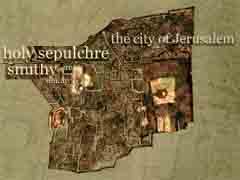 Remember the blacksmith. Adrian thought he was chivalrous, the same word the imam used about the brotherhood of Futuwwah. Maybe the blacksmith is one of them. Remember the blacksmith. Adrian thought he was chivalrous, the same word the imam used about the brotherhood of Futuwwah. Maybe the blacksmith is one of them.
When you get the map choose Saint Sepulchre - Smithy and you'll come directly there.
Talk to the blacksmith.
Hayyat often came to speak to the blacksmith after his day's work. He liked him. He does not think that Hayyat kidnapped the governor's daughter. He was a preacher and walked the streets of Jerusalem preaching of love. It did not harm anyone but the authorities preferred to lock him in. The blacksmith wanted to go and visit Hayyat in prison but one of the Chamberlain's men told him Hayyat had been hidden away. The blacksmith found this a little strange but did not insist.
He knows that Hayyat was born in the Jewish community of Burgos before his fellow Jews were expelled. His family sought refuge in Portugal. Then he was sold as a slave by Moslems and bought by Christians. He certainly had an adventurous life and one that brought him into close contact with men of all religions for better or for worse.
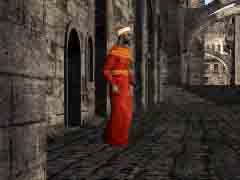
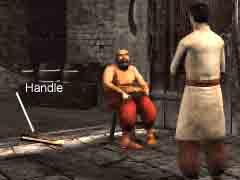 Suddenly you see a man sneaking out of Hayyat's house and hear the widow scream that the thief started a fire. Suddenly you see a man sneaking out of Hayyat's house and hear the widow scream that the thief started a fire.
When you get control quickly save your game.
A timed sequence has started, Turn around and pick up the handle lying on the ground to the left of the blacksmith. He offers to help with the fire.
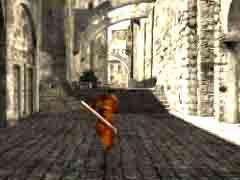
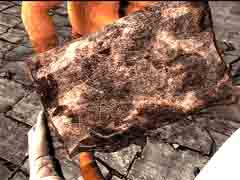 Turn around again and take a step forward through the arch. You see the thief. Quickly get the handle and click it on the thief. Turn around again and take a step forward through the arch. You see the thief. Quickly get the handle and click it on the thief.
Adrian thrown the handle and knocks the thief down. The blacksmith runs into the house and puts out the fire. He gives Adrian a half burnt Manuscript that he has rescued from the fire.
Adrian starts interrogating the thief but he is arrogant and calls Adrian a damned snoop an says that they can have him slung in prison but he won't stay there long because the Governors days are numbered.
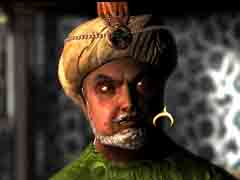
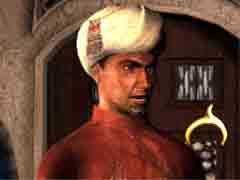 Hearing this, Adrian takes the thief to the Governor and tells him that someone had sent the man to Hayyat's house to find and destroy a manuscript that Adrian and Ozdemir had not found on their visit there. Hearing this, Adrian takes the thief to the Governor and tells him that someone had sent the man to Hayyat's house to find and destroy a manuscript that Adrian and Ozdemir had not found on their visit there.
Ozdemir adds that it seems they are not the only ones to be looking for Hayyat. He thinks that Hayyat has escaped from whoever was controlling him. And Adrian says that Hayyat could not have escaped, kidnapped the Governor's daughter and taken the relic all on his own.
He also asks where the dagger was kept. Ibrahim says that it was no secret that the dagger was kept in his work desk, everyone knew this. The Governor says he trusts Ibrahim completely. Ibrahim has served him for more than 30 years and also once saved the Governor's life.
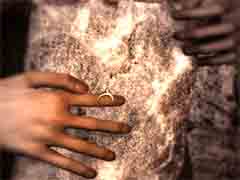
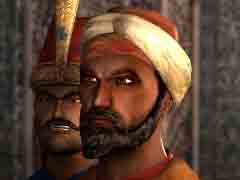 Asked about the Manuscript Adrian says that there is a quote in Hebrew from Isaiah on death, and two names written in Arabic, Nakir and Munhir, the Death Angels, and then a passage from the Epistle to the Romans concerning the Resurrection . Asked about the Manuscript Adrian says that there is a quote in Hebrew from Isaiah on death, and two names written in Arabic, Nakir and Munhir, the Death Angels, and then a passage from the Epistle to the Romans concerning the Resurrection .
It talks of death as a door which opens onto another existence, a better life. That is surely the path of Hope according to Hayyat.
Adrian says that he does not think the Governor will be lenient in his sentence unless the thief tells them who he is working for.
The thief answers: "He who asked me to search Hayyat's home would have no hesitation in making my loved ones pay if I betray him. Leave me a little while to think on which side I should tip the balance. Adrian says he wants his answer the next morning at dawn.
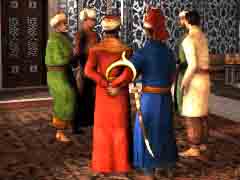 The Governor and his followers leave the room. The Governor and his followers leave the room.
When they are alone Adrian tells Ozdemir he has an idea, and wants Ozdemir to use his authority to discreetly watch the fire-maker's cell while Adrian himself pays a visit to one of their friends.
Ozdemir says that Adrian and Hayyat seem to have a lot in common an Adrian agrees, he has begun to like the old man, and he thinks they will find Hykmah tomorrow safe and sound.
"Unless something terrible happens to you beforehand " replies Ozdemir.
When you get the map go and see the Sufi in the library.
Library
 The Sufi agrees to talk to Adrian even though it is very late. The Sufi agrees to talk to Adrian even though it is very late.
He tells Adrian that Nakir and Monkir (Mounkir, Monkar) are Death-angels who weigh up the good and bad actions of everyone. Death separates the true believer from the false one and unmasks those hypocrites who have fulfilled their Moslem duties only from habit or conformity without adding faith. Those people Death sends to Gehenna, to Hell, where they will suffer for all eternity. The pious and sincere man, however, can join Allah's Paradise.
The Christian religion views death in a similar way. Those who have recognized the Good News of Jesus Christ will join the Father in Heaven, but Hell will be the destination for those who have refused to abdicate their pride before the generosity of Divine Forgiveness. But there is a major difference between Christian faith and Moslem faith, which is that, on the day of the Last Judgement, and in the example of Christ, the dead will be revived, that is what the apostles and Paul say.
With the Hebrews it is more complicated. For a long time they have maintained that the human soul survives until death but goes to reside in the Cheol, a sort of valley of shadows and sorrow where it cannot even praise God. Later, in the time when Christ was said to live, the Jews, then known as Sadducees, did not believe in the resurrection of the dead, while the Pharisees did believe. Today they believe, like the Moslems, in the survival of the soul but not resurrection of the dead.
You could say that the three religions agree that the souls journey does not end with the destruction of the body
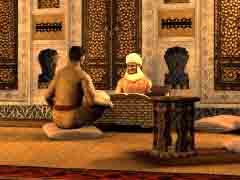 Adrian wants to know more about Ibrahim. Adrian wants to know more about Ibrahim.
The Sufi has known Ibrahim for ten years since he arrived in Jerusalem and says that Ibrahim is a good man and devoted to the Governor and hopes that Adrian does not suspect the poor man.
Adrian is curious why the Sufi calls Ibrahim a poor man.
That is because Ibrahim is abtar, he has no descendents and that is seen as a weakness for Moslems. Ibrahim has had many wives and even more concubines but no one ever gave him children and that is why the Governor did not want to marry him to Hykmah.
This makes Adrian even more suspicious and he decides to get to know Ibrahim better.
Leave the Sufi and go to the map.
|